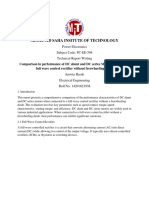NGR
NGR
Uploaded by
Achint RajputCopyright:
Available Formats
NGR
NGR
Uploaded by
Achint RajputCopyright
Available Formats
Share this document
Did you find this document useful?
Is this content inappropriate?
Copyright:
Available Formats
NGR
NGR
Uploaded by
Achint RajputCopyright:
Available Formats
Neutral Grounding Resistors
The purpose of a neutral grounding resistor is to limit the ground fault current to a safe level so that all the electrical equipment in the power system is protected. The resistor should be the only current path between the neutral of power transformers or power generators and ground. When the neutral of a system is not grounded it is possible for destructive transient overvoltages to appear from line to ground during normal switching of a circuit having a line to-ground fault. Experience has proved that these overvoltages cause aging and failure of insulation at locations on the system other than at the point of fault. In this way, a relatively unimportant line-to ground fault on one circuit may result in considerable damage to equipment and interruption of service on other circuits, not to mention the increased difficulty in finding the original location of the problem. A neutral grounding resistor is designed to limit the ground fault current to a safe value while at the same time letting enough current to flow to operate the protective relays that will clear the fault. While the disturbance lasts the resistor must be capable of absorbing and dissipating the energy generated without exceeding the temperature limits established by IEEE-32 Standards. In this way the fault is safely limited, isolated, and the power system is protected against overvoltages. Advantages of using a neutral grounding resistor: Reduced operation and maintenance expenses. Fast isolation of the original fault. Reduced transient overvoltages. Reduced physical damage on the equipment at fault. Simplification of ground fault location. Increased life and protection of transformers, generators and related equipment. Reduced frequency of faults. Improved service reliability. Increased protection in the use of lightning arresters. Increased safety for personnel.
Neutral Grounding Resistors
Features: Up to 5,000 amperes and up to 115,000 volts line to neutral. Galvanized Steel or Satin Coated Steel enclosures. Optional stainless steel and anodized aluminum frame and covers for corrosive atmospheres. Stainless steel nuts and bolts. Silver plated connectors and internal connections for positive contact and reduced oxidation. Indoor-outdoor service. Removable covers. Ventilated bottom screen. Protected against the entrance of rodents, birds or accidental contact by personnel. Continuous edge wound, stainless steel resistive elements without paralleling up to 1200 amps. Double insulation to ground. Designed to absorb thermal expansions and contractions. High-temperature, ceramic insulators. Standard bushings and insulators for easy replacement in case of damage. Entrance and exit bushings located according to customer's needs. Optional current or voltage transformers and relays for fault detection, mounted inside the enclosure with optional external terminal box. Rating, design, manufacturing and testing according to IEEE, NEMA and CSA standards. 24 month guarantee. Our models are named as follows: NGRvoltage-current-time where voltage is the line-to-neutral rms voltage, current is the limit current and time is the rated time,10s for ten seconds or C for continuous duty, i.e. NGR2400-400-10s or NGR347-5-C. Our standard models come with NEMA 3R galvanized steel enclosures painted color light gray ANSI 61 for indoor/outdoor use, (manual, test report and aluminum nameplates). Models above 600 Volts come with one external bushing for neutral connection. The following suffix codes can be added to the model name to denote special features: /NB: No bushings /GB: Add ground bushing /SS: Stainless steel enclosure /AL: Aluminum enclosure /N1: NEMA1 (indoor use) enclosure /N4: NEMA4 completely closed enclosure /Am: where A is the altitude when higher than 2000 meters above sea level (i.e. 3000masl) /SZ: Seismic zone special bracing /CT: Space for current or voltage transformer.
You might also like
- Reydisp Manager 2 Product Information V2.41Document24 pagesReydisp Manager 2 Product Information V2.41bureyh98No ratings yet
- Ebl264 3Document4 pagesEbl264 3cork_ie100% (2)
- The Technology of Instrument Transformers: Current and Voltage Measurement and Insulation SystemsFrom EverandThe Technology of Instrument Transformers: Current and Voltage Measurement and Insulation SystemsNo ratings yet
- UPK Classification Works ElectricalDocument1 pageUPK Classification Works ElectricallipanzyNo ratings yet
- Ashida 2010 Compact CatalogueDocument4 pagesAshida 2010 Compact Catalogueqaisar_shafi100% (1)
- Vector Surge Relay - MRG20000Document20 pagesVector Surge Relay - MRG20000t_syamprasadNo ratings yet
- FM Spae01 en BDocument12 pagesFM Spae01 en BSudhakar YsNo ratings yet
- Trivector MeterDocument2 pagesTrivector MeterTarun AhujaNo ratings yet
- Instantaneous Voltage Relay VAG11,21 High ResDocument4 pagesInstantaneous Voltage Relay VAG11,21 High ResManu ManojNo ratings yet
- 01 Vajhm23Document6 pages01 Vajhm23jigyeshNo ratings yet
- Canada Power Sf6Document22 pagesCanada Power Sf6alfonso.parkerNo ratings yet
- Indent No. Annexure - 1 Technical Specification of Alstom / Areva/ Make Protection Relay With Case. 1. CDG31 As Below Specs 4 NosDocument7 pagesIndent No. Annexure - 1 Technical Specification of Alstom / Areva/ Make Protection Relay With Case. 1. CDG31 As Below Specs 4 NosYaseen SagarNo ratings yet
- IRXm Product GuideDocument8 pagesIRXm Product Guidedeepak2628No ratings yet
- Spaj140c1 PDFDocument29 pagesSpaj140c1 PDFRihlesh ParlNo ratings yet
- Type VHXM: Under / Over Voltage RelayDocument6 pagesType VHXM: Under / Over Voltage RelayNikki AgarwalNo ratings yet
- MVAAM31 DiagramDocument1 pageMVAAM31 DiagramMahmudNo ratings yet
- Power System Protection Lectures - Instrument TransformersDocument56 pagesPower System Protection Lectures - Instrument TransformersavishekNo ratings yet
- Auxiliary RelayDocument5 pagesAuxiliary RelayVijayaganthaan VisvanatthanNo ratings yet
- HT Cables ResistanceDocument28 pagesHT Cables ResistanceNagendran MNo ratings yet
- Instrument Safety Factor of Current TransformerDocument16 pagesInstrument Safety Factor of Current TransformerEngr saqibNo ratings yet
- Types and Applications of Overcurrent Relay Part 1Document10 pagesTypes and Applications of Overcurrent Relay Part 1carlos vidalNo ratings yet
- Dokumen - Tips - Numerical Rho 3 Motor Protection Relay Easun R Current TransformerDocument4 pagesDokumen - Tips - Numerical Rho 3 Motor Protection Relay Easun R Current TransformerPAWAN RAJPUTNo ratings yet
- DGA of CT OilDocument13 pagesDGA of CT Oilraza239No ratings yet
- High Impedance Differential Protection 7VH60Document7 pagesHigh Impedance Differential Protection 7VH60Mohamed TalebNo ratings yet
- Double Element Voltage Operated Auxiliary Relay - VAA21 / Self-Reset Contacts Vaa21 YfDocument4 pagesDouble Element Voltage Operated Auxiliary Relay - VAA21 / Self-Reset Contacts Vaa21 YfAshwini Kumar RaiNo ratings yet
- Benefits of A Variable Frequency DriveDocument4 pagesBenefits of A Variable Frequency Drivemt6760No ratings yet
- SIP5 6MD85-86 V07.50 Manual C015-9 en PDFDocument1,216 pagesSIP5 6MD85-86 V07.50 Manual C015-9 en PDFandreabautista1982No ratings yet
- What Is Earthing Transformer or Grounding TransformerDocument12 pagesWhat Is Earthing Transformer or Grounding Transformersampath kumarNo ratings yet
- VTXDocument6 pagesVTXHari Krishna.MNo ratings yet
- High Voltage Busbar ProtectionDocument45 pagesHigh Voltage Busbar ProtectionabhinavksauravNo ratings yet
- Prok ManualDocument8 pagesProk ManualaymaanfkNo ratings yet
- CDG 31eg Test ReportDocument1 pageCDG 31eg Test ReportshiyasNo ratings yet
- Generator ProtectionDocument72 pagesGenerator ProtectionJennifer SimpsonNo ratings yet
- High Impedance REFDocument3 pagesHigh Impedance REFYogi RegarNo ratings yet
- 6 +acsr+zebra+conductorDocument17 pages6 +acsr+zebra+conductorBagusIrawanSaputraNo ratings yet
- SEL 351 RelayDocument7 pagesSEL 351 RelayMohammed shamaaNo ratings yet
- 07 SEP674 RET670 Overexcitation Protection PDFDocument17 pages07 SEP674 RET670 Overexcitation Protection PDFarunmozhiNo ratings yet
- Designing Over Current Relay Logic in MATLABDocument4 pagesDesigning Over Current Relay Logic in MATLABAl Imam AkbarNo ratings yet
- SIP5 7UM85 V07.30 Manual C027-2 enDocument1,756 pagesSIP5 7UM85 V07.30 Manual C027-2 enMarioyfernanda Guerra MuruaNo ratings yet
- 025 - Auto Reclose Relay Rev-ADocument4 pages025 - Auto Reclose Relay Rev-AMohammad NasarNo ratings yet
- Auxiliary Relays RXMB 1 RXMB 2 and RXMC 1Document12 pagesAuxiliary Relays RXMB 1 RXMB 2 and RXMC 1jenskg100% (1)
- Cag 1737Document5 pagesCag 1737Anonymous HuHbq4OR100% (2)
- Supervision RelayDocument3 pagesSupervision RelayBassem Mostafa100% (1)
- Megawin Switchgear: Numerical Over Current ProtectionDocument4 pagesMegawin Switchgear: Numerical Over Current ProtectionRock hackNo ratings yet
- Three Phase HTCT Multi Port Meter Er300pDocument3 pagesThree Phase HTCT Multi Port Meter Er300pD RAJANNo ratings yet
- Installation and Service Instructions 12 ... 24 KV - 630 ... 4000 A - 16 ... 50 KaDocument88 pagesInstallation and Service Instructions 12 ... 24 KV - 630 ... 4000 A - 16 ... 50 KaPetre GabrielNo ratings yet
- mc61c PDFDocument32 pagesmc61c PDFashishchugh44No ratings yet
- Gen Testing ScheduleDocument30 pagesGen Testing Schedulekrishkar2010No ratings yet
- Protection CAG 14Document2 pagesProtection CAG 14david wyethNo ratings yet
- Fundamentals of Distance Protection: GE MultilinDocument111 pagesFundamentals of Distance Protection: GE MultilinCarlos CaballeroNo ratings yet
- p345 Technical ManualDocument1 pagep345 Technical ManualabhayambujNo ratings yet
- File For Transformer Safety DeviceDocument21 pagesFile For Transformer Safety Devicebalajichoicecentar100% (1)
- Chapter 7Document15 pagesChapter 7Khaled RabeaNo ratings yet
- MetrosilDocument4 pagesMetrosilSuranjana DasNo ratings yet
- Shanthala Power Limited,: Energy Meter Test Report-On SiteDocument1 pageShanthala Power Limited,: Energy Meter Test Report-On Sitedan_geplNo ratings yet
- CCUM21Document4 pagesCCUM21Ranjit Das100% (1)
- List of Aux. Relay and Protection RelayDocument4 pagesList of Aux. Relay and Protection Relaypadmawar100% (2)
- Vaj CortecDocument6 pagesVaj CortecvenkateshbitraNo ratings yet
- Neutral Grounding ResistorsDocument5 pagesNeutral Grounding Resistorsnhan209a100% (1)
- Neutral Earthing ResistorsDocument4 pagesNeutral Earthing ResistorsjaytamijNo ratings yet
- Ngcat00 PDFDocument4 pagesNgcat00 PDFK.RamachandranNo ratings yet
- HVPNL 400 KV PPP-1 Transmission Project (Jhajjar Power) : Manual of Specifications & StandardsDocument45 pagesHVPNL 400 KV PPP-1 Transmission Project (Jhajjar Power) : Manual of Specifications & StandardschethannitkNo ratings yet
- Isolation Transformer Role in UPSDocument26 pagesIsolation Transformer Role in UPSAchint Rajput100% (1)
- 52CP Wiring Diagrams 52cp-2wDocument8 pages52CP Wiring Diagrams 52cp-2wSyed Noman AhmedNo ratings yet
- Senthil KumarDocument3 pagesSenthil KumarAchint RajputNo ratings yet
- Record 260 TV Record 260 TV Record 260 TV Record 260 TV: ARM RD260STV KFP /1PRISMA/2R24H11Document156 pagesRecord 260 TV Record 260 TV Record 260 TV Record 260 TV: ARM RD260STV KFP /1PRISMA/2R24H11chupinfabriceNo ratings yet
- ID Group ParameterDocument82 pagesID Group Parametergiapy0000No ratings yet
- 520 Kva Step Down Trafo MWP 02Document21 pages520 Kva Step Down Trafo MWP 02KIRUBANESANNo ratings yet
- Differential ProtectionDocument20 pagesDifferential ProtectionsherubdNo ratings yet
- 250.194 Grounding and Bonding of Fences and Other Metal StructuresDocument3 pages250.194 Grounding and Bonding of Fences and Other Metal StructuresAnonymous mNQq7ojNo ratings yet
- VRF Electrical DiagramsDocument3 pagesVRF Electrical Diagramscalvin.bloodaxe447867% (3)
- Thermal Power PlantDocument33 pagesThermal Power PlantManoj KumarNo ratings yet
- Trip CKT Sup XR350Document3 pagesTrip CKT Sup XR350mmsaNo ratings yet
- 01 - NZM MCCB BoucherDocument40 pages01 - NZM MCCB BoucherPhaniNo ratings yet
- Hager Residual Current DevicesDocument21 pagesHager Residual Current DeviceselectricalenginNo ratings yet
- Troubleshooting Linear Power Supply Was Quite EasyDocument2 pagesTroubleshooting Linear Power Supply Was Quite EasyNAYEEMNo ratings yet
- Jasleen - Physics Investigatory ProjectDocument17 pagesJasleen - Physics Investigatory ProjectDaily Meme DOSENo ratings yet
- Service Entrance - Overhead ER 19-240-K: Single & Three Phase 100, 200, & 320/400 AmpDocument6 pagesService Entrance - Overhead ER 19-240-K: Single & Three Phase 100, 200, & 320/400 AmpRyan ƁoŋŋęrNo ratings yet
- And Reactance of Is Connected To The Generating Station Bus-Bars Through 5 MVA Step-Up Transformer Having ADocument7 pagesAnd Reactance of Is Connected To The Generating Station Bus-Bars Through 5 MVA Step-Up Transformer Having AJames SantosNo ratings yet
- 2015 10 20 UPS Battery Systems Handout 1ADocument20 pages2015 10 20 UPS Battery Systems Handout 1AroyclhorNo ratings yet
- Acti9 IK60A Katalog IndonesiaDocument2 pagesActi9 IK60A Katalog IndonesiaHansen LaMessiah SaputraNo ratings yet
- Ansi Codes For Electrical SystemsDocument4 pagesAnsi Codes For Electrical SystemspmankadNo ratings yet
- ABB LV Low Voltage Fuses & Fuse LinksDocument24 pagesABB LV Low Voltage Fuses & Fuse LinksFiko007No ratings yet
- Sun2000 100KTL M1Document2 pagesSun2000 100KTL M1Panuwat TimoiuNo ratings yet
- Sistemas de Corriente AlternaDocument2 pagesSistemas de Corriente AlternaErick Eduardo Barrantes QuirosNo ratings yet
- Trafo ProtectionDocument12 pagesTrafo Protectionnishant choudharyNo ratings yet
- Electrical Distribution Box, DescriptionDocument3 pagesElectrical Distribution Box, Descriptionvitor santosNo ratings yet
- Trafoindo Catalogue Instrument Transformers PDFDocument6 pagesTrafoindo Catalogue Instrument Transformers PDFAhmad Reza FahloviNo ratings yet
- AC Switches DC Switches: Click To ViewDocument32 pagesAC Switches DC Switches: Click To ViewY.a. OoiNo ratings yet
- Power ElectronicsDocument4 pagesPower Electronicsanwita.basakNo ratings yet
- PE Assignment Set WiseDocument26 pagesPE Assignment Set WiseDiya SharmaNo ratings yet
- Protection Guide of SSEE Power Transformer PDFDocument177 pagesProtection Guide of SSEE Power Transformer PDFIvanNo ratings yet




























































































